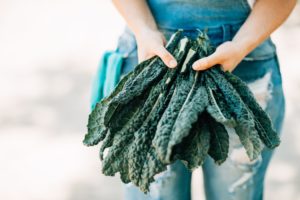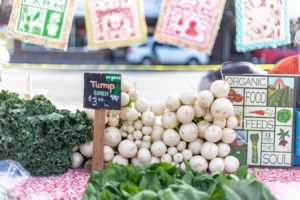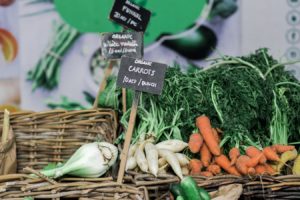Gardener’s Guide: How to Sell your Homegrown Produce
So you’ve decided that gardening isn’t just a hobby anymore, huh? Maybe it’s gotten too expensive to garden for no profit; maybe your family refuses to eat what you grow; or maybe you’ve recognized a need in your community for homegrown produce. Whatever the reason, if you want to begin selling your produce at your local farmer’s market then you’ve come to the right place. Here, we’ll discuss how to sell your homegrown produce to make a profit and gain big rewards.
How to Sell Homegrown Produce
Before diving in, it’s important to scope out the local produce landscape. Farmer’s markets are great places to sell homegrown produce, but consider why they’re in your community to begin with. Does your community contain a lot of health-conscious or environmentally-conscious people? Or perhaps your grocery store is lacking in the produce department?
A smart marketer (or farmer, tomato-tomato) will investigate his or her client-base before growing any produce. You want your selection of goods to appeal to your community, so offer what they’re looking for. Consider the following:
- If your community is very health-conscious then consider going the all-natural route to appeal to their senses. For instance, don’t use pesticides or herbicides in your garden. If they are environmentally-conscious, advertise some ecofriendly gardening methods you employ.
- Take inventory of your competitors’ produce. What does the local grocery store sell and what are they missing? What are others at the farmer’s market selling? Don’t grow what’s already in stock; grow what’s in demand.
- Ask your neighbors and friends what kinds of produce they like best or what they wish they had access to. You could even take a poll or survey.
- Don’t just grow what’s in demand. Introduce something new and exciting to your community. Research unique fruits and vegetables that are definitely not offered in your area. This will surely give you a competitive edge.
Be Garden-Smart
Once you’ve gathered your information, it’s time to begin planting. Remember, you’re no longer gardening as a hobby–you’re selling your homegrown produce. Therefore, it’s important that your produce is healthy, visually-appealing, nutritious, and safe for consumers.
To Sell Homegrown Produce, Grow Healthy and Safe Produce
You’ll want to prevent plant diseases so you don’t lose money in the process of growing for profit. As a rule of thumb, keep clean tools and a clean work space. Dirty tools are one of the main causes of Pythium, a plant disease that kills plants’ roots and is impossible to eradicate. For more tips, you can read our comprehensive gardener’s guide on preventing plant diseases here.
Of course, your plants’ health isn’t the only thing you should worry about. It would be extremely unfortunate if anyone were to contract an illness after eating your produce, so follow good gardening practices to ensure this doesn’t happen. Take preventative measures when it comes to diseases, such as E Coli. (Here is an excellent article from Colorado State University describing how to prevent E Coli from developing on vegetables.)
Watch out for insects or other pests that transmit disease. Some slugs are known to carry nematodes that can travel to consumers’ stomachs (and once they’re there, they never leave). Typically, humans contract these parasites by not washing their vegetables, with which the slugs have come into contact. You can prevent these slugs from coming into contact with your produce by introducing predators, such as frogs. For more information, you can read this gardener’s guide, which contains a list of animals and insects that can benefit your garden.

Lastly, you’ll want to ensure that the produce you’re presenting is nutritious and aesthetically appealing. Fertilizer is the best way to introduce nutrients to your soil, and vegetables grown with fertilizer are more nutritious. (If you’re not sure which fertilizer you should buy, read our gardener’s guide, which reviews the pros and cons of different fertilizer types.) But quickly, let’s review a few tips on fertilizer selection:
Choose the Right Fertilizer
- Choose one with a high nitrogen content, as nitrogen is responsible for the growth and vibrant color of plants’ leaves. You’ll want your produce to look as vibrant and large as possible to appeal to consumers.
- If you’re environmentally conscious or will want to use this as a marketing technique, you should find an organic or natural fertilizer. Manure, compost, and liquid fertilizers are the most ecofriendly options around.
- Don’t buy fertilizer high in salts. Salt can negatively affect soil health and plant development.
- For an ecofriendly liquid fertilizer that contains no salts and is high in nitrogen, check out xVital.
Now that the gardening aspect is out of the way, it’s time to think about how to sell your homegrown produce.
Market Before you Sell at the Farmer’s Market
Now you’re thinking: okay, so I know what I want to plant and how to do it correctly, but how do I sell my homegrown produce?
Well, it isn’t enough to simply bring boxes of produce to the farmer’s market. These days, marketing is everything. If you want to sell your produce at the farmer’s market, connect and communicate with consumers, and earn big rewards then you’ll need to kick it up a notch.
People like to know from where they’re getting their food. You can take professional or semi-professional photos of your garden or farm and write up a small “introduction” to let consumers know where the produce is grown. Providing a backstory about why you began your side-hustle is also a great technique to garner interest.

Additionally, you’ll want to beautify your produce. It’s not enough to have fresh, vibrant greens. Create cute tags to let consumers know the name and price of the produce. You can also create recipe cards to let consumers know how they should cook the produce (this is an especially great trick if you’re selling something unique or exotic).
For those who plan to sell canned, pickled, dried, or candied goods that they’ve grown, consider the type of packing you’ll use. Printing recipes on the back of jars or packages is good business sense, and if you provide homemade or family recipes, you could have greater appeal.
If you want your side-hustle to flourish into something bigger, you could also create a website, print business cards, and design flyers.
Be Business-Smart
If you want to make a profit, you’ll need to be business smart. Don’t mark down your prices to make friends (in fact, it could deter people from buying your produce. Cheap often equates to low quality). But don’t overprice people either. Consumers know how much they should pay for something. Of course, if you’re selling something exotic that they can’t get anywhere locally, the price can be raised.

And be careful with words like organic. Organic is a tricky term, and farmers need certification to label their produce as such. While those selling at farmer’s markets are exempt from such certification, you should ensure that your produce is truly organic before labeling it as such. Here is an excellent article, which includes a checklist, on organic labeling in farmer’s markets.
Lastly, remember that you’ll have to shovel out some money before you can make some. The cost of supplies, gas to get to and from the market, and helpers (if you hire any) will need to be calculated. It will take time before you see a profit from selling your produce, but it is a rewarding task. Even if you don’t make money in the first year or two, you will have forged a connection with your community and provided a quality product. It’s also a great experience for those with the entrepreneurial spirit!
Don’t let the fear of failing stop you. Begin with the mindset that you’re selling your produce as a hobby, and once you begin making a profit, transition to an entrepreneurial stance. Selling to those with an interest in your produce is much better than letting it rot in your garden or in the cabinet.


